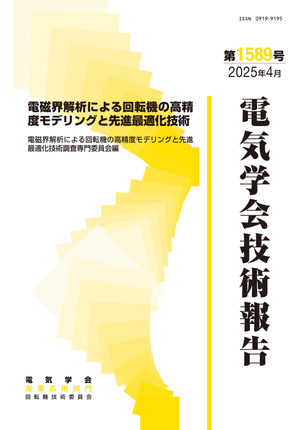電磁界解析による回転機の高精度モデリングと先進最適化技術
電磁界解析による回転機の高精度モデリングと先進最適化技術
カテゴリ: 技術報告
論文No: 1589
グループ名: 【D】産業応用部門
発行日: 2025/04/15
タイトル(英語): High-Precision Modeling of Rotating Machines by Electromagnetic Field Analysis and Advanced Optimization Technology
著者名: 電磁界解析による回転機の高精度モデリングと先進最適化技術調査専門委員会
著者名(英語): Investigating R&D Committee on High-Precision Modeling of Rotating Machines by Electromagnetic Field Analysis and Advanced Optimization Technology
キーワード: 回転機,電磁界解析,有限要素法,モータ最適化,公開可能バーチャルモータ/Rotating Machines, Electromagnetic Field Analysis, FEM, Motor Optimization, Virtual Motors
要約(日本語): カーボンニュートラルの実現に向け、クリーンエネルギーの活用や機械式から電動式への移行、いわゆる電化が多くの分野で活発に検討されている。その中で、回転機の利用拡大は今後も重要な役割を果たすと考えられる。 近年、回転機の電磁界解析技術の進展や新たな解析手法の開発、これらを用いた特性算出技術の研究が活発に行われている。回転機の特性評価において電磁界解析は不可欠な技術であり、有限要素法を中心に様々な解析手法が研究されている。 モータ最適化に関連して、寸法最適化やトポロジー最適化が主要な手法として用いられており、例えば平均トルクを維持しつつトルクリプルを大幅に低減する形状を探索可能であることが示されている。また、近年ではAIや機械学習を活用した形状最適化も進展している。例えば、永久磁石の配置を多数ケース学習させることで、所望のトルクを出力する形状や損失を低減する形状を効率的に評価できることが明らかとなっている。さらに、モータ最適化に利用可能なバーチャルモータが公開モータとして選定され、紹介されている。 本技術報告は、電磁界解析に携わる技術者のみならず、AIや機械学習をモータ設計に取り入れたい技術者にとっても有益な内容となっている。
要約(英語): In pursuit of carbon neutrality, the adoption of clean energy and the transition from mechanical to electrical systems, commonly referred to as electrification, are being actively explored across various fields. Among these, the expansion of rotating machine applications is expected to continue playing a central role. Recent trends include advancements in electromagnetic field analysis technologies for rotating machines, the development of new analytical methods, and research into their applications for performance evaluation. Electromagnetic field analysis is an essential technology for evaluating rotating machine characteristics, with studies being conducted using the finite element method and other approaches. In motor optimization, dimensional optimization and topology optimization are primarily employed to explore optimal shapes. For example, it has been demonstrated that shapes capable of significantly reducing torque ripple while maintaining average torque can be identified. Moreover, recent progress has been made in applying AI and machine learning to shape optimization. By training models on numerous cases of permanent magnet placement, it is possible to efficiently evaluate shapes that achieve desired torque output or reduce losses. Additionally, virtual motors suitable for optimization purposes have been selected and introduced as publicly available motors. This technical report provides valuable insights not only for engineers involved in electromagnetic field analysis but also for those seeking to integrate AI and machine learning into motor design.
PDFファイルサイズ: 15,827 Kバイト
受取状況を読み込めませんでした




